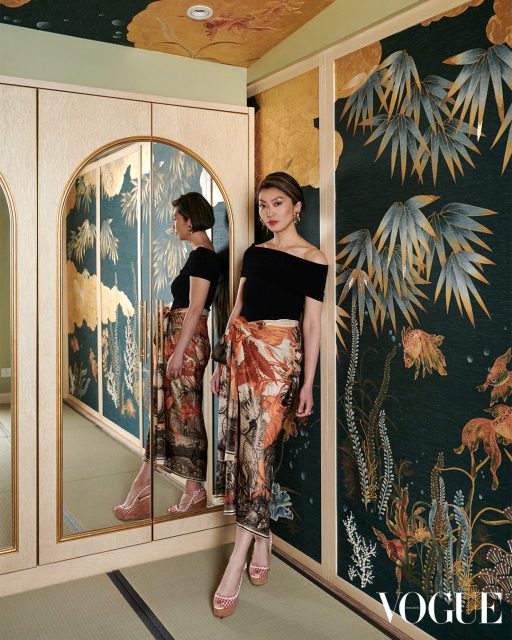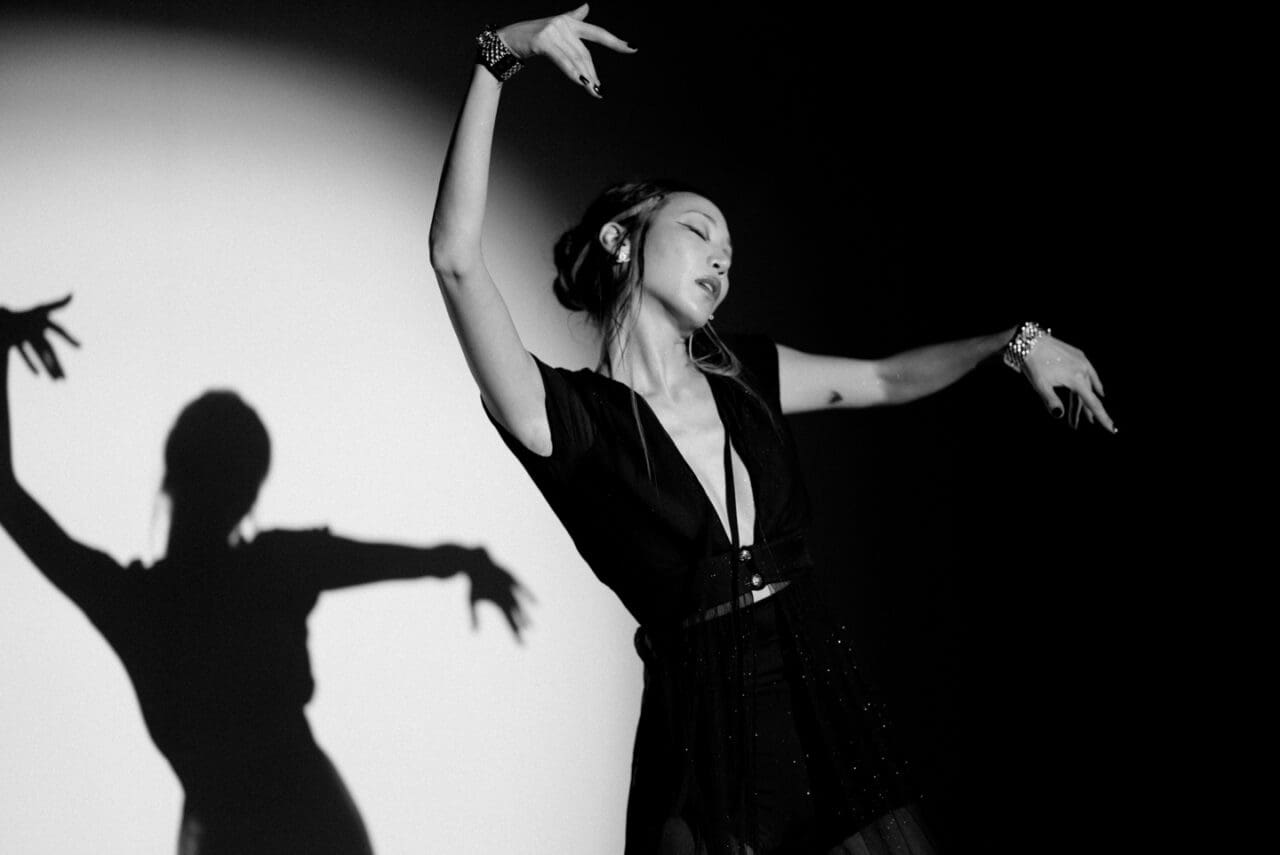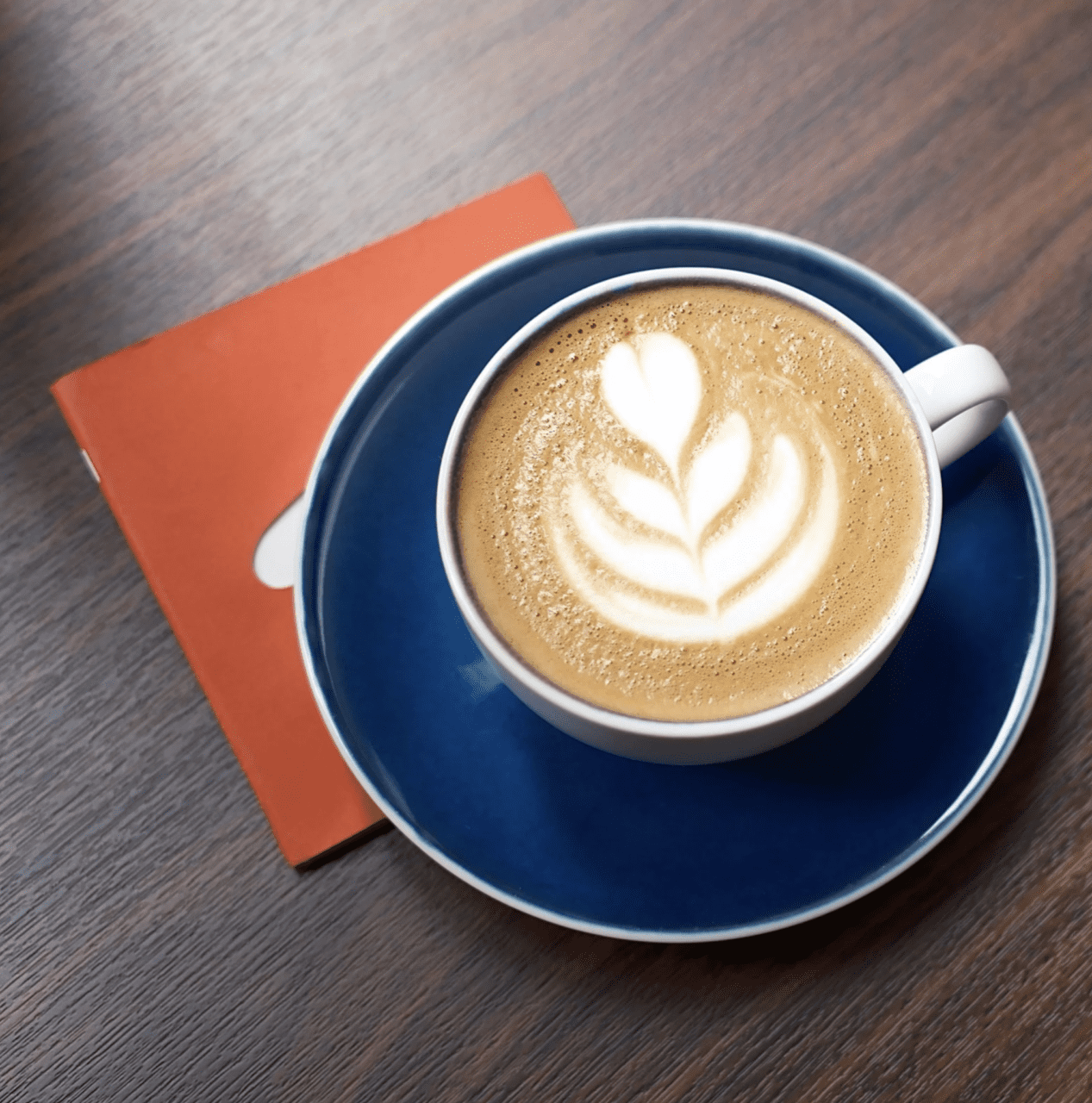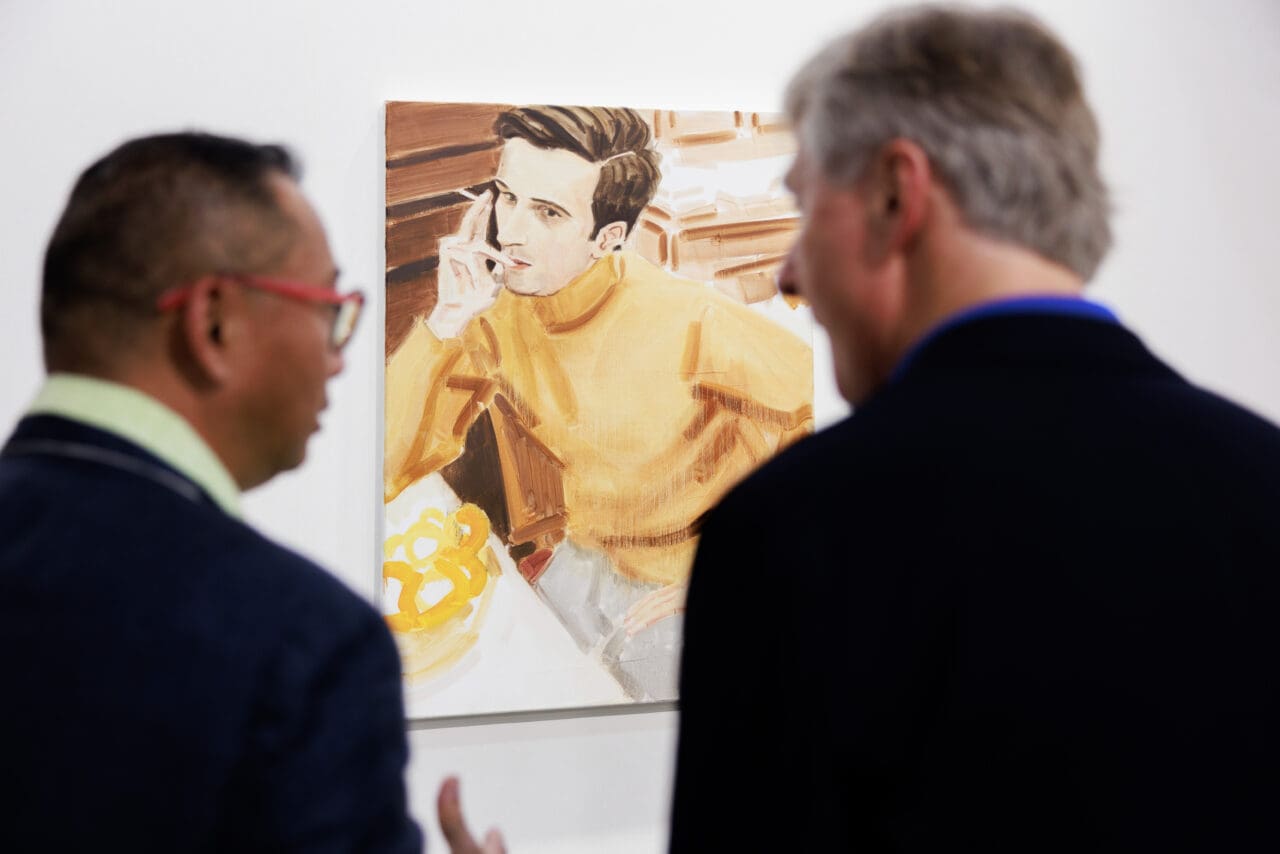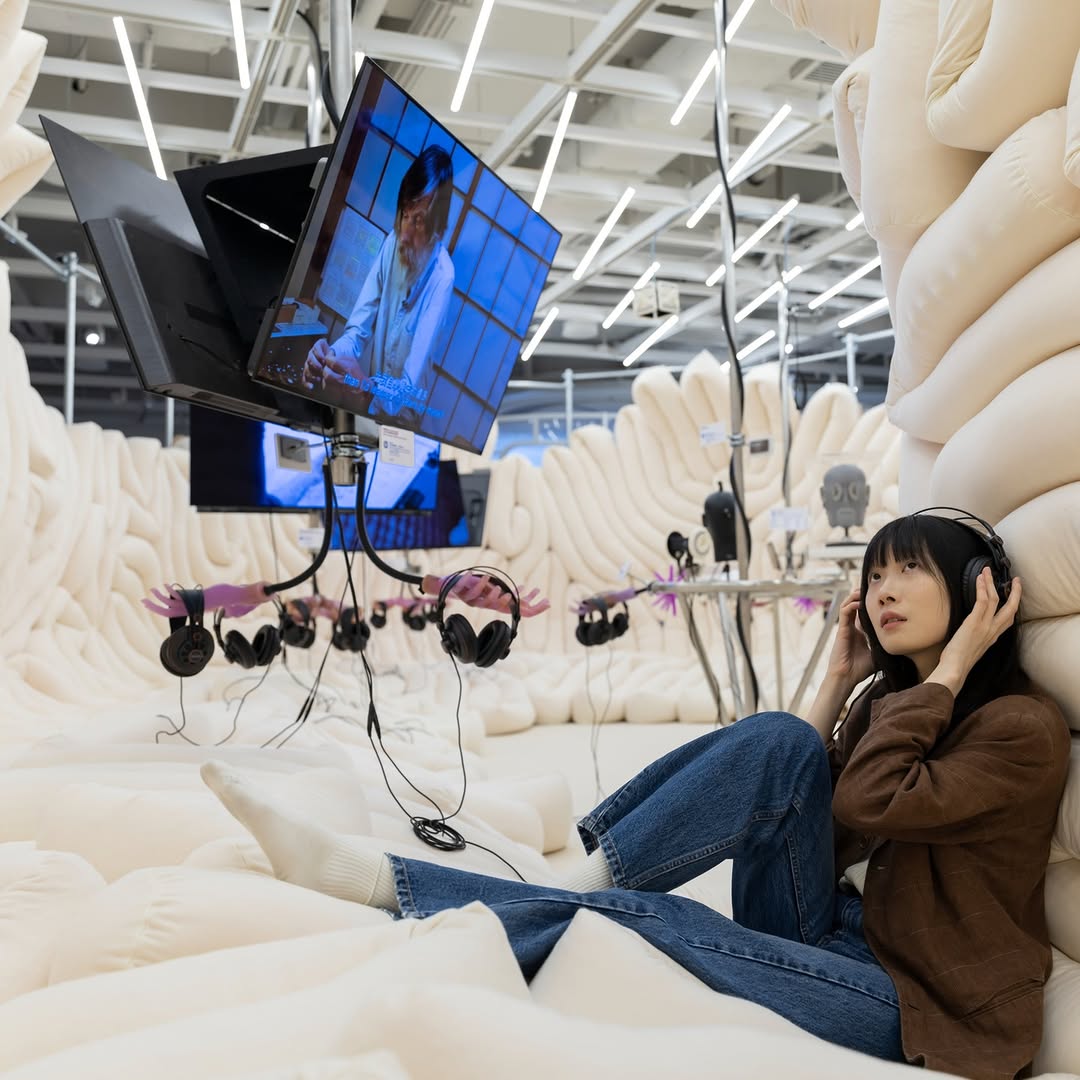At this year’s Milan Design Week, V-ZUG embarked on an exploration of time and matter, unveiling a thematic installation within an illustrious museum and a brand new showroom in the heart of the Italian city. Both spaces spoke the same design language—one forged by creative kindred spirits Elisa Ossino and Henry Timi.
Bound by a shared appetite for purity and materiality, the two Italian designers joined hands for the V-ZUG ‘Time and Matter’ installation. They transformed the Sala Aldo Bassetti within Milan’s Pinacoteca di Brera into a poetic investigation of the kitchen, highlighting its unique propensity to continuously evolve alongside modernity without sacrificing its ties to an earlier vision of life.
V-ZUG's 'Time and Matter' installation at the Pinacoteca di Brera.
Photo: Courtesy of V-ZUG
Flanked by grandiose paintings of the heavens above were raw blocks of travertine fashioned into stools and kitchen furnishings that housed various V-ZUG appliances in an extraordinary display of contrast. Sleek pillars of V-ZUG ovens stood grounded by rough hunks of stone, whilst a particularly porous slab concealed an induction cooktop. It was a visual juxtaposition that told more than just a story of past and present; it was a reminder of the inescapable importance of matter in our technology-driven lives.
The new V-ZUG flagship at Piazza San Marco 4.
Photo: Courtesy of V-ZUG
This message perpetuated the interiors of the new V-ZUG Studio Milan too, the brand’s first ever Italian flagship. Ossino’s belief in the strength of simplicity came through in clean lines, lots of open space, and a minimalistic palette of colours that allowed material to once again take centre stage. Crafted together with Timi were sculptural pieces that transformed the showroom space from a mere exhibition into a place also designed for human interaction—with both each other and the physical aspects of the studio. The V-ZUG collaborators walk Vogue Hong Kong through the V-ZUG worlds they have created, and dig deep into the magic of the kitchen.
This is now your third Milan Design Week installation for V-ZUG. How does it feel?
Elisa Ossino: I’m very happy with this collaboration, I think that year after year we are doing something more extraordinary than the last. It gives us the possibility to develop new ideas, and a new way of living. In the new V-ZUG Studio Milan and above all, in the installation over at Pinacoteca di Brera, we are talking about and reflecting on the evolution of the times. This is a historical moment where technology has become a part of our daily lives, but we feel more and more this necessity to go back to our origins, to our archetypes and to the matter. That’s why we work a lot around that contrast between technology and the archaic.
Could you introduce us to the concept behind this year’s installation work ‘Time and Matter’? What are some of the key themes being explored?
Henry Timi: It is a primordial space, where you can rediscover the authentic connection with natural material through functional works of essential beauty. The sublimated forms tell of the ancestral experience of true feelings, and at the same time bind us to the world of becoming thanks to the cutting-edge technology that is presented [within].
This is also the first time you two are collaborating with each other. What has it been like working together?
E: We have known each other for a long time and we have been admiring the work of the other ever since. So when there was this opportunity to work together, we were really happy. I think that this is only the beginning of our collaboration, because it’s a very interesting meeting. Between us, we have a very similar vision of the purity of forms, of the importance of matter. We have many shared visions, so we really loved working together on this project.
H: The partnership with Elisa and V-ZUG leads to confirming the expression of a search for wanting to tell values such as matter, craftsmanship, research, and their time, through different points of view, using diverse materials and shapes but at the same time pointing towards the same constellation.
We have known each other for many years and there is a mutual respect that links us. Elisa is a person of great sensitivity; among the international designers more in line with my stylistic path. This is why it is with great pleasure that we share the passion project that in this edition was born as a path of continuous and extreme research, combining our ideas and transforming them into functional artworks. These works are the communion of a journey that has been going on for years with V-ZUG; united in purpose and factuality, they are the emerging result of art applied to function.
What materials have you chosen for these V-ZUG projects and why?
H: The ethereal light and the shadow that fades. From the iconic beige of the travertine that frescoes the thousand-year-old Italian landscape, to black limestone that fades into grey vicenza. A vocabulary of the national stone that aims to enhance its peculiarities through workmanship synonymous with HENRYTIMI art, such as the split coast, the rough hand-worked rock, or sublime smoothness.
Were there any technical or creative challenges you faced with this piece?
E: A big challenge was incorporating the appliances into the big sculptural pieces—it wasn’t so easy and we tried to create a new language. The appliances are hidden inside these blocks, these beautiful artworks, and discovering them [as an audience] is a very special surprise. It’s a very impactful installation.
Apart from the main Time and Matter installation, you also worked on a series of furniture items. Could you tell us more about these pieces?
E: Here in the new V-ZUG Studio Milan we created the kitchen island, the table and the kitchen stools together. It’s a collection of unique artworks; in each piece you will never have the same block of stone. Each block carries a richness and its own special meaning, and the way each sculptor works with the stone is completely different. These pieces are not industrial, they are made by hand with a special block of stone. They are so important; they are like sculptures.
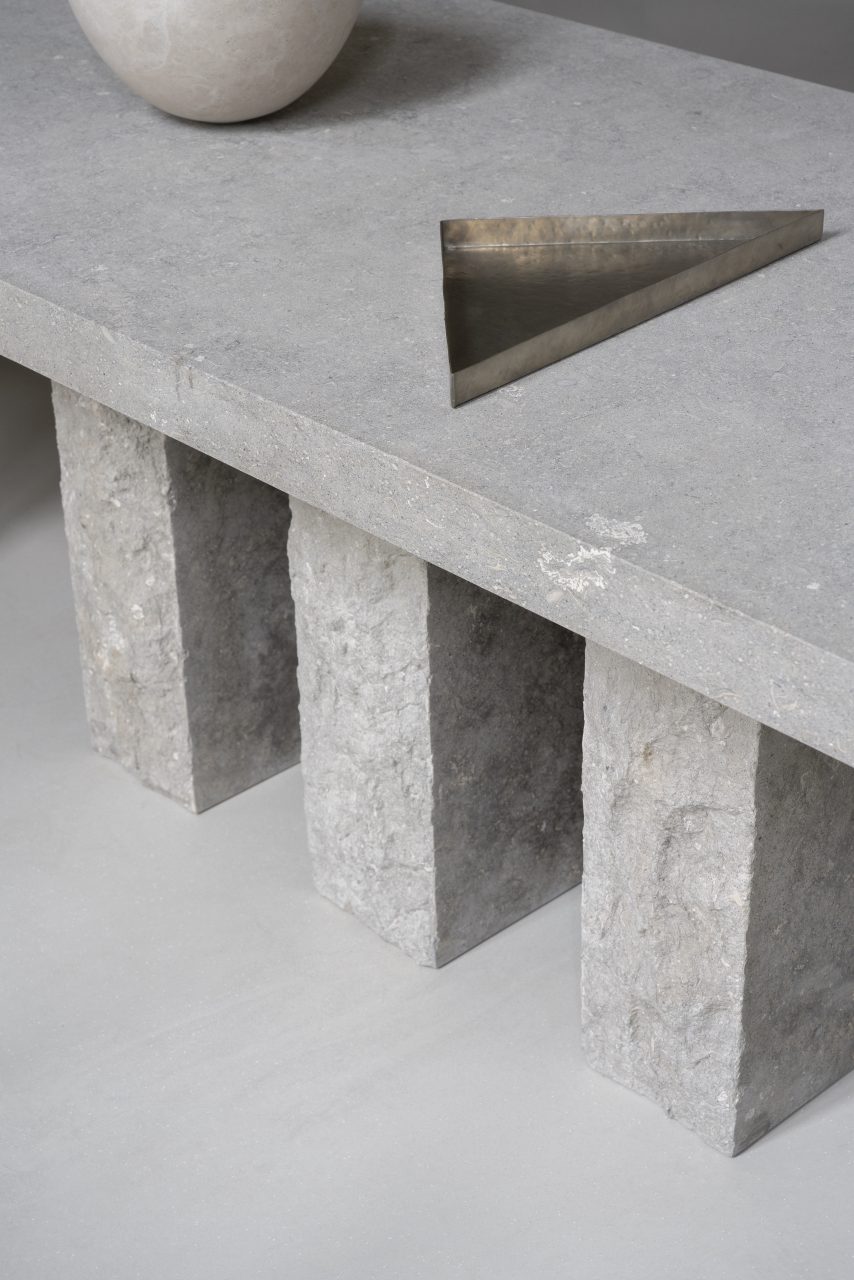
A sculptural artwork by Elisa Ossino and HENRYTIMI juxtaposes smooth and rough surfaces.
Photo: Courtesy of V-ZUG
How do you personally define humanistic design, and what is its significance in this project?
E: With video, we see a big evolution with technology becoming a part of our everyday lives. There is this kind of situation in which people feel as though technology has become a part of our existence. We have a different sense of technology now with artificial intelligence, with virtual reality. But in opposition to virtuality, you have this necessity to go back to the origins and to touch the matter. After some reflection this kind of contrast is what I call techno-archaic. This is why I feel this project is a historical moment. People need a more humanistic design because we have to touch and feel matter, not just technology.
H: Human in its natural essence; the creation of works aimed at harmonising the forms by referring to the careful study of geometries. And at the same time, it is human also because the objective and studied function is always aimed at enhancing the form of objective beauty. It is balanced, in stasis with every matter, colour, detail, and space.
Elisa, you coined the term ‘techno-archaic’ to describe your design approach. Why is it so important that we also go back to our origins?
I don’t think that we have to go back, so to speak. It’s impossible because technology is a part of our life. For example, with these appliances you can live much better; they [facilitate] wellness for people because, thanks to these technologies you can cook in [ways that enrich your life]. So I think it’s fantastic that we have technology. But at the same time, we need to also have the matter. To use the word contrast is not so correct. It’s a kind of meeting between two elements that look opposite, but in reality is just the aesthetic [nature] of this present moment in history.
When I see the installation in the Pinacoteca, I feel that it is [a reflection of] a historical moment that we are living in. I feel very comfortable with that vision, because we have matter and the necessity to touch the matter, but there is also technology and the importance of having technology in our everyday life. The two things together, it’s amazing.
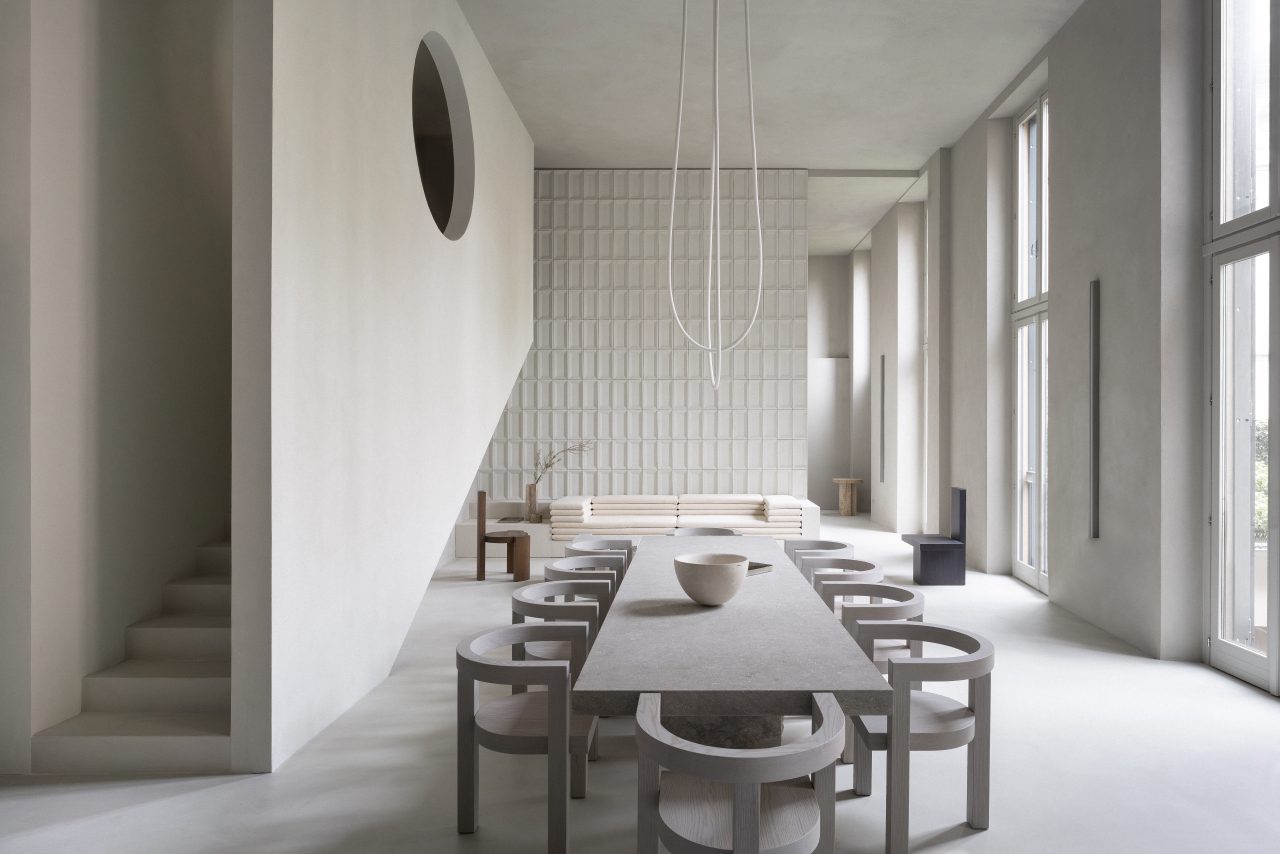
The V-ZUG Studio Milan is an embodiment of Swiss values both within and beyond design.
Photo: Courtesy of V-ZUG
What were some of your most interesting sources of inspiration for this project?
E: Nature, for sure. It is one of the most inspiring elements of all my work. You cannot see it everywhere, but nature is the place where ideas come out. When I have been working a lot, then I need to leave the city and work amongst nature; I like to work and to feel it. When I am in that context I try to stop to think because I need to have a moment of quiet and relaxation. Only then do the ideas and the visions come up. It’s very strange. [Nature] is a place that creates an emptiness in my mind, [which in turn] brings me visions of projects. So it’s also helpful for me in the double sense: I feel much better and relaxed, but I also take inspiration and vision for my work.
Did you grow up around nature?
E: Yes, all of my childhood was spent in nature. I was born in Sicily. It’s a nice land and there is all this seaside around so as a child I was always close to the sea. In the middle, Sicily has this big volcano that is still active and there are these black stones, these amazing volcanic stones. We also used the pigment of volcanic stones from Sicily to create the surface of the cupboard downstairs. All of the cupboards behind the kitchen island are made with a special concrete; we asked the manufacturer to create this mix of concrete using volcanic stone, bringing this incredible volcanic energy from Sicily.
The kitchen space at the new V-ZUG Studio Milan.
Photo: Courtesy of V-ZUG
With ‘Time and Matter’, we are looking at an artistic interpretation of both the evolution of the kitchen and V-ZUG’s advocacy of responsible cooking. From a design perspective, what makes the kitchen a unique space of interest to you?
E: The kitchen is a very special place in the house. For me, it is the most important because during archaic times we had these things called focolare domestico. It was the fire in the middle of the room, and the central place of a house. All the people were living around the fire and cooking. I think that there is still something magical and archaic in the space of the kitchen. Where there is the fire—or in any case the induction—there is this transformation of the food in a kind of alchemic process. And I really love this because it’s the only space in the house where you can have a kind of magic transformation.
Then there is another thing in my vision as a designer—I love abstract space. All my research for many years is concentrated on this concept, because I like to have functional space, but I like to completely hide the function of the room. I enjoy creating interiors in which the space is enough and clean but you have some strong elements, some signs that remain on your mind. For example, with this space there is the concrete wall with the 3D tiles, you have the big lamp, and you have the extraordinary artworks, but then all the doors of the cupboards are completely hidden inside the walls. You have all the functionality, but also a few sculptural elements that transform the space in a very abstract way and that remain in the mind of people who enter this space.
H: The kitchen is a creative hotbed, a place of evolution, a place of care for both matter and the person. It is surrounded by an always direct contact with natural elements such as fire and water, which bring us back to an essential state of life. One regenerates in every act and at the same time the act is the guardian of knowledge, tradition, and evolution.
In terms of your personal life, how would you describe your relationship with the kitchen? Is it a space that you often spend time in?
E: Yes, I do. It’s one of my biggest passions to cook and I cook a lot also for fun. For me, to cook for people is like giving a present. When people are happy with the food I feel very grateful and very joyful, it’s like giving love to the people who are with you. So absolutely yes, I love it.
H: I am also an aesthete in search of food.
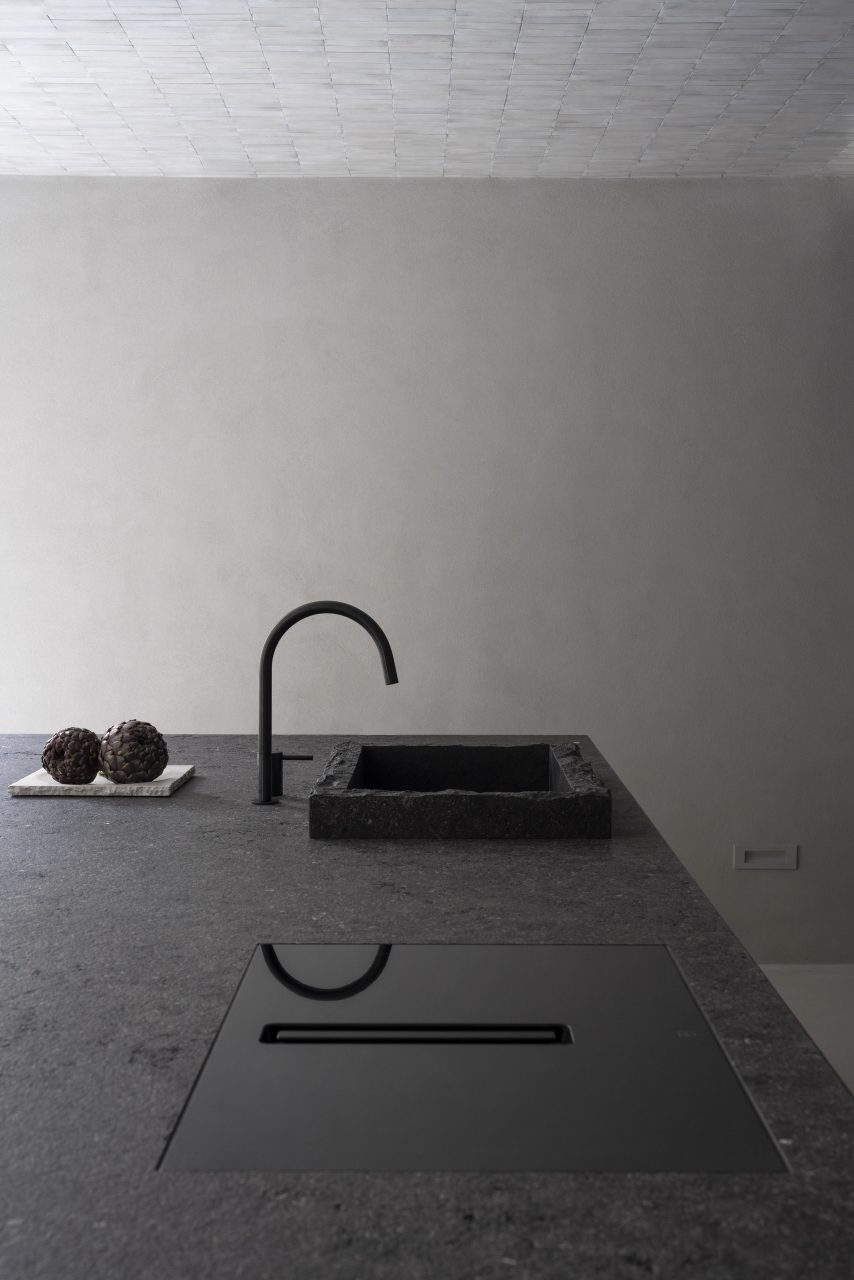
A V-ZUG induction cooktop is incorporated into one of Elisa Ossino and HENRYTIMI's collaborative artworks at the Milan showroom.
Photo: Courtesy of V-ZUG
What’s your last minute go-to recipe?
E: A very good last minute one is aglio olio with peperoncino made in a Sicilian way, with some special dried tomatoes that I mix with garlic and basil. My olio is organic extra virgin olive oil that I produced because I have my own tree on my land in Sicily. So I mix these together with spaghetti and peperoncino, then prepare it with some toasted bread crumbs. This is my last minute recipe—very loved by everybody!
Have you learned anything new about yourself and your practice since you began working with the Swiss brand?
H: We mutually give knowledge and new insights into our profession and creative innovation—of which V-ZUG are promoters— involving new energies towards new, unexpected shapes and lines.
E: I think I learned a lot more as a cook because now I cook a lot with the V-ZUG ovens. I really love them because I’m experimenting with new recipes. All my friends are very happy with this new collaboration because I’m making some interesting and new plates. So there is a double aspect to this [experience].
Editor
Alyanna Raissa J. PayosCredit
Lead image: Courtesy of V-ZUG





